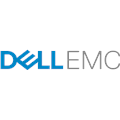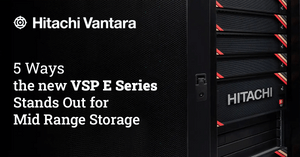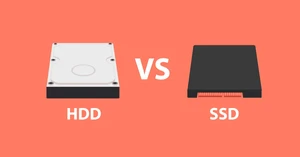Storage devices are an important component of a computing system, facilitating the storage, porting, and extraction of data files. These memory storage devices can store data, information, files, and so on both temporarily and permanently, as per the user’s requirements.
What is a Storage Device?
A storage device is essentially a hardware unit in a computing system where information, files, objects, and data are stored. These devices are used for porting, extracting, and storing data temporarily or permanently. Data storage units can be internal to a computing device or added externally, as per your needs.
There are different types of storage devices with varied structures and sizes, differentiated based on their functionality and underlying device type. The data storage devices can store all the data and applications in a computing device, besides the hardware firmware.
Types of Computer Storage Devices
Data storage devices can be of different types, as per their functionality, structure, device type, size, and so on. Given below is a list of storage devices of computers, that are primary, secondary, and tertiary storage:
- Primary Storage Devices: A primary storage device, also known as internal memory, is a computer storage device that is designed to hold data temporarily. These storage devices are directly accessible to the Central Processing Unit (CPU) and have a fast data access speed. Primary storage devices are volatile and smaller in size, mostly used to store program instructions, input data, and intermediate results. Some examples of primary storage include random access memory (RAM), read-only memory (ROM), cache memory, etc.
- Secondary Storage Devices: Secondary storage devices are mostly external data storage units with no accessibility to the central processing unit. These devices are designed to store data permanently until the memory storage device is removed from the computing system. Secondary storage devices are non-volatile with a larger storage capacity, used for long-term storage of data and programs. USB, floppy disks, optical disk drives, and so on, are examples of secondary storage devices.
- Tertiary Storage Devices: Tertiary storage devices are external storage units that are used for mounting and unmounting mass storage data. These devices are used to store robotic functions, and hence, rarely used in personal computing systems. Tertiary storage devices function automatically, without the need for human intervention.
List of Computer Storage Devices
Within the different types of storage devices, there is a list of storage devices, bifurcated based on their specifications, storage capacity, and use. Primary storage, magnetic storage, optical storage, flash memory storage, and cloud storage are some of the computer storage devices:
- Primary Storage Devices: Primary storage devices are internal storage units with volatile memory, used for temporary data storage. There are mainly two types of primary storage devices, Random Access Memory (RAM) and Read Only Memory (ROM):
- Random Access Memory (RAM): Random access memory is a memory storage device with temporary memory that stores information and data for immediate use. RAM comes installed on a hard disk in the computing device and runs multiple tasks like application loading, web browsing, document editing, and so on.
The data on RAM gets deleted by shutting down the computing device. On average, RAM storage capacity ranges between 1GB to 32GB, depending on the requirement of the device. There are several types of RAM devices, including Static Random Access Memory (SRAM), Dynamic Random Access Memory (DRAM), and Synchronous Dynamic Random Access Memory (SDRAM).
- Read-Only Memory (ROM): Read-only memory is a non-volatile memory storage device where the stored data cannot be edited or modified. The data in this memory storage device is saved permanently at the time of manufacturing.
ROM is used to store instructions related to starting the computing device, also referred to as bootstrap operation. The storage capacity of these devices ranges between 4MB to 8MB. There are mainly two types of ROM devices, which are Programmable Read-Only Memory (PROM) and Erasable Programmable Read-Only Memory (EPROM).
- Magnetic Storage Devices: Magnetic storage devices are external storage devices that can store large quantities of data and information through magnetized mediums. Upon installation, a magnetic field is created between the device and the computing system, allowing the computer to read binary language and store information. Some of the commonly used magnetic storage devices include floppy disks, hard drives, and magnetic strips:
- Floppy Disk: It is a removable memory storage device comprised of magnetic elements for storing information and data.
- Hard Drive: Hard drives are attached to the motherboard’s disk controller and used to install new programs and applications in a computing system.
- Magnetic Strip/Card: Magnetic strips and magnetic cards contain digital data in the form of iron-based magnetic particles. Magnetic strips include debit cards, credit cards, identity cards, etc.
- Tape Cassette: Tapes and music cassettes are also examples of magnetic storage devices, storing data in an analog magnetic tape.
- Flash Memory Devices: Flash memory devices are essentially portable storage devices used to store and transfer data efficiently. Pen drives, SSD devices, SD cards, memory cards, and multimedia cards are some of the commonly used examples of flash memory devices:
- Pen Drive: A USB flash drive stores flash memory integrated with a USB interface. These devices can be connected to any computing device to read/write data and information.
- Solid State Drive (SSD): SSDs are mass-storage devices that store data using non-volatile storage.
- Secure Digital (SD) Card: SD Cards are portable storage devices used in devices like phones, digital cameras, and so on, for storing large data.
- Memory Card: Similar to SD cards, memory cards are used in digital cameras, printers, game consoles, and so on, to store large amounts of data.
- Multimedia Card: MMC cards are external storage devices used in radios, digital cameras, etc, to store media files and information.
- Optical Storage Devices: Optical storage devices are secondary storage devices that use lasers and lights to detect and store data. Optical storage includes CDs, DVDs, Blu-ray Disc, and so on:
- Compact Disc (CD): CDs are optical storage devices that contain tracks and sectors on their surface to store data.
- Digital Versatile Disc (DVS): DVSs are similar to CDs, with a higher storage capacity.
- Blu-ray Disc: Blu-ray discs are another example of optical storage devices that run on a Blu-ray disc reader. These devices contain violet lasers to store information in greater density and longer wavelengths.
- Cloud and Virtual Storage: Virtual or cloud storage is also a part of secondary memory, where storage is hosted on third-party servers and accessible over the internet on a pay-as-you-go basis. Here, the data and information are stored on the cloud, and the underlying infrastructure is maintained by the cloud service provider at physical data centers.
Characteristics of Computer Storage Devices
External storage devices are characterized by their ease of usage, mobility, volatile nature, scalability, and accessibility:
- Mobility: A key characteristic of storage devices is that the data can be easily removed from one device and replaced with another. These devices give users the freedom to transfer data between different devices efficiently.
- Readable/Writable: The data and information in computer storage devices can be edited, replaced, and deleted as per the user’s requirements.
- Easy to Use: Another characteristic of data storage devices is that they are easy to use and do not require any technical skills to handle.
- Scalable: External storage devices have scalable storage capacities that can be increased or replaced with the growing storage requirements of the user.
- Non-volatile: An important characteristic of data storage devices is that they are non-volatile and can be used to store data permanently in the long term.
- Accessible: Accessing data storage devices is easy and convenient. The devices are easily accessible online and offline, as per the user’s needs.
Why data storage is important?
Data storage is important to enhance the storage capabilities of the computing device, reduce costs on infrastructure investments, and increase data security:
- Enhanced Storage Efficiency: Utilizing data storage devices in file and database backups, archival data storage, and storing non-critical business data reduces the consumption of primary storage of the device. With the help of a storage device, you can optimally utilize data storage by segregating data, files, and folders based on their criticality, access frequency, size, and other factors.
- Cost Reduction: Data storage devices help in reducing the overall storage cost by offering a low cost per unit of storage. These devices offer high storage capacity at lower costs to store mass data quantities with ease. Storage media devices are especially beneficial for backup purposes, where large storage capacities are needed for redundant data storage. By shifting infrequently accessed data to storage devices, users can yield cost savings.
- Security and Data Recovery: Storage devices add an extra layer of security against data loss and unauthorized access. These devices are external and removable, allowing off-site data storage and preventing cyber threats. With the help of data storage devices, users can ensure that critical data remains disconnected from online or internal networks.
- Mobility and Flexibility: Data storage devices provide mobility, empowering individuals and businesses to effortlessly transfer data between different devices. With the help of data storage, users can enhance productivity by accessing and manipulating data on the go. Using storage devices allows you to share files, media, and information with different devices or access files offline, adding to work flexibility.
- Scalable Data Storage: Another advantage of data storage devices is that these devices offer versatile storage capabilities as per user’s requirements. With an increase in storage demand, users can scale the storage infrastructure with ease. These storage devices ensure effective management of data growth with cost-effectiveness. Storage media devices offer scalable solutions tailored to user requirements.
Measuring storage amounts
Data storage determines the quantity of data that can be stored in a computer system. There are various units that are used to measure the storage amount of a device, including bytes, kilobytes, megabytes, gigabytes, terabytes, petabytes, and so on:
- Bytes: Bytes are the smallest unit of measuring the data storage capacity of a device. A byte comprises eight successive binary digits, that can either be a 0 or 1.
- Kilobytes (KB): KB is the second-smallest unit to measure data storage unit. A kilobyte generally consists of 1,024 (210) bytes.
- Megabytes (MB): MB can store up to one million (220) bytes.
- Gigabytes (GB): A gigabyte contains one billion (230) bytes.
- Terabytes (TB): One trillion (240) bytes are contained in one terabyte.
- Petabytes (PB): A petabyte equates to 1 quadrillion (250) bytes.
- Exabytes (EB): 1 quintillion (260) bytes are contained in 1 EB.
- Zettabytes (ZB): Zettabytes have 1 sextillion (270) bytes.
- Yottabyte (YB): YB is the largest data storage unit. 1 septillion (280) bytes are contained in a single yottabyte.
Top 10 Storage Devices Comparison
Below is a comparison of the 10 latest storage devices on the basis of their key features and pricing:
| Top 10 Storage Devices Comparison |
| Storage Devices | Key Features | Storage Devices Pricing |
| NetApp E2800 Series | Affordable Performance, Cloud Connectivity, Proven Simplicity, Worry-Free Reliability, Advanced Data Protection, Higher Flexibility | Price on Request |
| NetApp FAS Storage Express Pack | Storage Efficiency, Backup and Recovery, Maintain Business Continuity, Nondisruptive Operations, Performance and scalability, Cloud Integration | Starting at ₹546,250 |
| NetApp AFF C190 | Deploy workloads in under 10 minutes, Use a single system for file and block data, Effortlessly connect to public clouds, Improve storage efficiency to control costs, Secure your application data, Accelerate application performance with flash | Price on Request |
| NetApp AFF A-Series | Build your Hybrid cloud with ease, Provision storage in minutes, Integrated data protection, Modernize with advanced NVMe, Scale without disruption, Business continuity and fast disaster recovery | Price on Request |
| Dell EMC SC5020 Storage Array | Power Supply: 1485W or 1378W, Physical Dimension: 13.33 cm x 44.5 cm x 78.5 cm (or 5.25 in x 17.52 in x 30.9 in)., I/O & Expansion: iSCSI, FC, and SAS, Operating System: Dell Storage Center OS, Operating Environment: Temperature range of 50 – 95°F, Form Factor: Storage Array 3U | Price on Request |
| Dell EMC Unity 300 Hybrid Flash Storage | Processor Specifications: 2 x Intel® Xeon® E5-2603 6-Core 1.6 GHz, Drive Description: 2.5" SAS/Flash (2U), 25 drives 3.5" SAS/Flash (3U), 15, Controller: Number of Controllers/VSD/ Node | Starting at ₹551,286 |
| Dell EMC Unity 350F All-Flash Storage | Processor Specifications: 2 x Intel® Xeon® E5-2603v4 6-Core 1.7 GHz, Drive Description: 2.5" SAS/Flash (2U), 25 drives Min/Max Drives- 6/150 Max Raw Capacity- 2.4 PB CPU per Array | Price on Request |
| ME4024 Storage Array | Data Security, Improve Performance, Data Management, Fast Process, SAN Storage Snapshots, Encryption | Price on Request |
| VNX Series | Processor Specifications: Disk Processors Holds disk drives) or storage processor enclosure requires disk drive tray) plus standby power system, Power Supply: Standby Power system., RAID Technology Support: Raid options : 0/1/10/3/5/6, Memory Specifications: CPU/Memory Per Array : Ranging from 8 GB to 96 GB. Max Raw Capacity : Ranging from 225 TB to 2970 TB. | Price on Request |
| Huawei ES3000 V5 SSD | High Performance, PCIe, SAS Interfaces, Fast, Powerful, and Reliable, Database, Cloud Services | Price on Request |





















